NeurIPS 2017
摘要
Dealing with sparse rewards is one of the biggest challenges in Reinforcement Learning (RL). We present a novel technique called Hindsight Experience Replay which allows sample-efficient learning from rewards which are sparse and binary and therefore avoid the need for complicated reward engineering. It can be combined with an arbitrary off-policy RL algorithm and may be seen as a form of implicit curriculum.
We demonstrate our approach on the task of manipulating objects with a robotic arm. In particular, we run experiments on three different tasks: pushing, sliding, and pick-and-place, in each case using only binary rewards indicating whether or not the task is completed. Our ablation studies show that Hindsight Experience Replay is a crucial ingredient which makes training possible in these challenging environments. We show that our policies trained on a physics simulation can be deployed on a physical robot and successfully complete the task.
处理稀疏奖励是强化学习的最大挑战之一。我们提出了一种新的技术称为 "事后诸葛亮"(Hindsight Experience Replay),它允许从稀疏的二进制奖励中进行有效的样本学习,从而避免了复杂的奖励设计工程。它可以与任意的off-policy RL算法相结合,可以被看作是一种隐式的课程学习。
我们在用机器人手臂操纵物体的任务上展示了我们的方法。特别的,我们在三个不同的任务上进行了实验:推、滑和取放,在每一种情况下都只使用二进制奖励来表示任务是否完成。我们的消融研究表明,HER是一个关键因素,它使训练在这些具有挑战性的环境中成为可能。同时我们在模拟环境中训练的策略可以部署在物理机器人上,并成功完成任务。
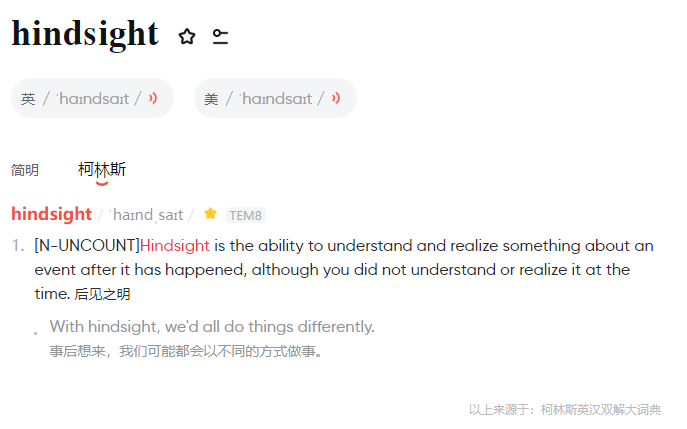
研究动机
- Reward Shaping:需要专业领域知识,且会限制智能体的能力。
- 稀疏奖励(0-1二元奖励)挑战
- 从错误轨迹学习:(a example)打球没进篮筐,可以是投篮动作错误,也可以是篮筐位置不对
主要贡献
- 提出HER的技术:重放episode时考虑不同的目标,而不只智能体期望达到的
- 该技术可以和任何off-policy的方法进行组合
- HER提高了采样效率,也可以从稀疏奖励环境中学习
方法描述
Multi-goal RL
目标定义:$g \in \mathcal{G}$满足$f_g: \mathcal{S} \mapsto \{0,1\}$,当完成目标是$f_g(s) = 1$
- 目标空间与状态空间等价:$\mathcal{S} = \mathcal{G}$,$f_g(s) = [s=g]$
- 目标空间是状态空间的子集:例如$\mathcal{S} = \mathbb{R}^2$为平面坐标系,$\mathcal{G}=\mathbb{R}$为x轴坐标,所以$f_g((x,y))=[x=g]$
- 假设给定状态$s$可以很容易找到目标$g$满足该状态,即存在映射$m:\mathcal{S} \mapsto\mathcal{G}$ $\text{s.t.}$ $\forall_{s \in \mathcal{S}} f_{m(s)}(s)=1$

具体实现方法很简单(这也是我看的论文算法介绍部分最短的)
- 在收集完一个episode经验后重采样额外目标,直接对transition进行修改并放入经验池
额外目标选择方式(消融实验部分介绍)
- Final:将episode最后一个状态$s_T$作为回放目标
- Future:从当前transition之后状态中随机选取k个状态作为回放目标
- Episode:从当前episode所有状态中随机选取k个状态作为回放目标
- Random:从当前整个训练过程所遇到过的所有状态中随机选取k个状态作为回放目标
理论分析
无
实验验证
实验环境:基于MuJoCo自建的一个环境(OpenAI已将其封装在Gym环境中)https://openai.com/blog/ingredients-for-robotics-research/
- Pushing:将箱子推至目标位置
- Sliding:击打冰球至目标位置(该位置机械手臂无法到达)
- Pick-and-place:将箱子抓取到目标位置(目标位置在空中)
实验分析
- Does HER improve performance?
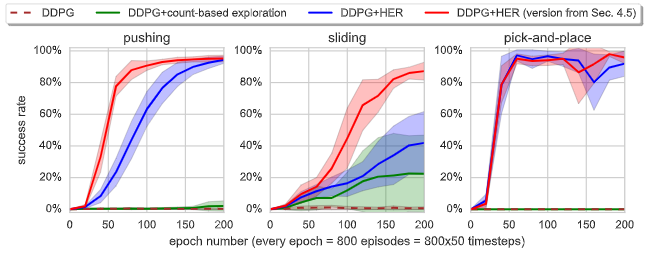
Does HER improve performance even if there is only one goal we care about?
- 和上图对比,多目标的训练更快
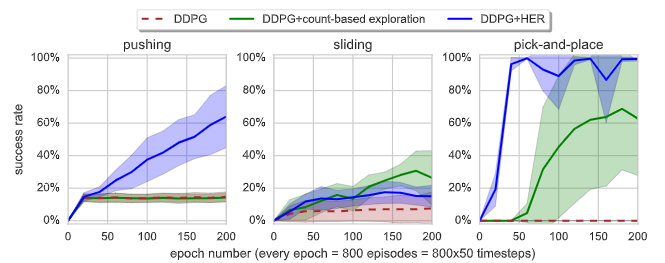
How does HER interact with reward shaping?
- 奖励函数:$r(s,a,g) = \lambda|g-s_{\text{object}}|^p-|g-s'_{\text{obejct}}|^p$,其中$\lambda \in \{0,1\}, p\in\{1,2\}$
- Reward Shaping性能差原因:1)奖励函数设计和实际成功条件存在巨大差异;2)依据shaped reward惩罚行为可能会阻碍探索
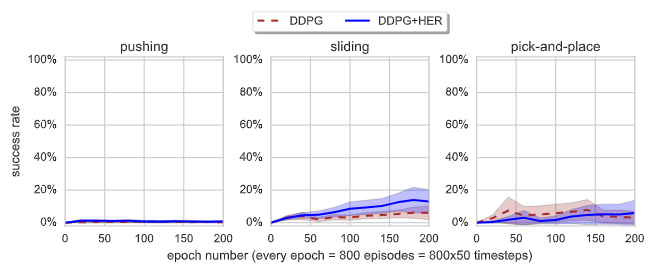
How many goals should we replay each trajectory with and how to choose them?
- 每次重构transition选择的目标数量k
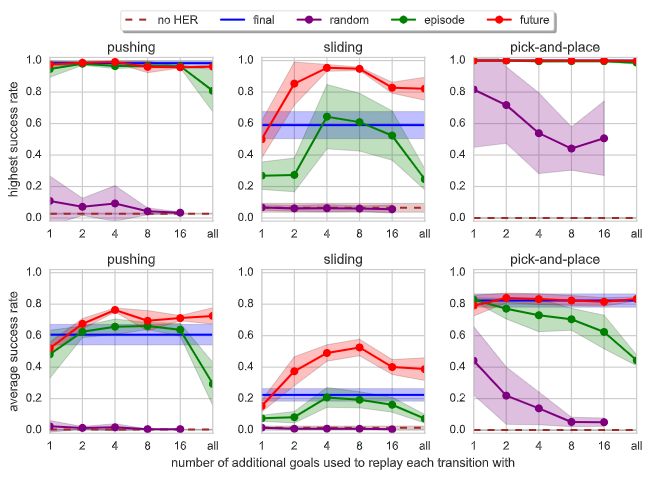
- Deployment on a physical robot

其他思考
- 本文是OpenAI大佬们的文章,没有严谨的数学推导,想法比较简单且有效,很容易理解。另外实验部分的问题写作法可以学习。
- 还是存在一个较大问题是,对于目标的定义过于简单,文章说目标部分的假设(可以很容易找到状态对应的目标)并不具备局限性通常可满足,单可能还是对于目标定义存在争论,该目标只适用于导航类任务(即目标是一个具体的坐标位置),暂时没有想到其他的任务可以如此简单定义目标。或者在复杂环境中很难直接通过当前状态设定对应目标,例如Atari游戏。
原文链接:https://proceedings.neurips.cc/paper/2017/file/453fadbd8a1a3af50a9df4df899537b5-Paper.pdf
参考资料:https://zhuanlan.zhihu.com/p/34309324 & https://zhuanlan.zhihu.com/p/501043736
